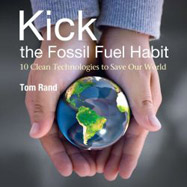Guest post by: Tom Rand
 We’ve hit the bottom of the global oil barrel. Thousands of rigs far out at sea stick giant straws through more than a mile of sea-water, and drill down for miles more to pierce our remaining pockets of oil. Those pockets may be big enough to wreck the Gulf, but they’re so small in global energy terms that they couldn’t supply the global economy for a day. In the Canadian Tar Sands, they melt tar and turn it into oil, which is akin to turning diamonds into coal.
We’ve hit the bottom of the global oil barrel. Thousands of rigs far out at sea stick giant straws through more than a mile of sea-water, and drill down for miles more to pierce our remaining pockets of oil. Those pockets may be big enough to wreck the Gulf, but they’re so small in global energy terms that they couldn’t supply the global economy for a day. In the Canadian Tar Sands, they melt tar and turn it into oil, which is akin to turning diamonds into coal.
The expertise we bring to access these last bits of oil is impressive – but peak oil and climate change dictate it’s a losing game. Investments in the Tar Sands and deep-water drilling bring no lasting wealth, only short-term economic gain at significant environmental expense.
The larger tragedy revealed by the BP spill is that we lack the imagination to re-direct that expertise and capital to safer, cleaner sources of energy. The lesson to learn is not about safer drilling in deep water. Instead of drilling for oil at sea, we could drill for heat here on land.
Traditional geothermal is well understood. The heat of the earth’s crust sometimes pokes up near the surface, warming underground aquifers. Tap that liquid, and use the heat to drive a turbine. But these plants are limited to a few areas where conditions are just right.
The holy grail of renewable energy is enhanced geothermal (EGS). Drill a few miles down pretty much anywhere, and you reach hot, dry rock. EGS is the art of fracturing that rock, and circulating fluid to extract the heat and produce electricity. EGS can produce power 24 hours a day, eliminating the intermittency associated with other renewable sources. It can provide base-load power.
The amount of available energy is enormous. A 2006 report by the Massachusetts Institute of Technology estimated that EGS can deliver many thousands of times our total energy needs. It can go a long way to greening our grid, and electrifying transport.
Power plants take up a few square kilometers of land, extracting heat from the large volume of rock underneath. Each drilled section lasts 5 or 6 years, when you drill another set of holes. The original section slowly re-heats. Each cubic kilometer of rock, lowered by only 1 degree, delivers the energy equivalent of 70,000 tonnes of coal. This is not kid stuff.
Want to replace coal plants? Drill a couple of holes, facture the rock, and replace the furnace with a heat exchanger. Keep the rest of the infrastructure, and say goodbye to coal. If the cost of the capital needed to drill and fracture the rock is less than the cost of coal (and carbon risk) it’s no-brainer.
Want to think really big? A trillion dollars of EGS plants could replace the entire North American coal infrastructure. That may sound like a lot of money, but the US spends about that much on oil, each and every year.
EGS isn’t just theoretical; in fact, there are operating plants in France and Germany, and lots of drilling has started in Australia. The guys from Google see promise, and have made investments in new drilling and fracturing technology.
It’s not a stretch to imagine oil companies going after EGS. They routinely drill into the earth’s crust, at sea and on land, seeking oil and gas. Geological engineers have lots of experience fracturing underground rock to clear natural gas wells, and do it now to extract gas from shale.
But oil companies need a push to get into the renewable energy game. As long as there are scraps of oil to tap, they will remain distracted from safer, cleaner alternatives. A strong pricing signal on carbon, set to rise over time, will get their attention. The provision of low-cost debt for renewable energy projects, like EGS, will keep it.
Government intervention has driven innovation and created wealth in the past. The U.S. interstate highway system was funded by the federal government in the 1950s. That paved the way for the auto sector to fuel the North American economy for almost half a century. Silicon Valley was founded on military and academic support of the microchip processor.
Kicking our fossil fuel habit will drive the next industrial revolution, and the US needs to show leadership. We do not need to stick giant straws into the deep sea to pierce the last remaining pockets of oil. We just need energy. And that can be found everywhere, if you just drill deep enough.
Tom Rand is Cleantech Lead Advisor at MaRS Discovery District; a venture capitalist; and author of Kick the Fossil Fuel Habit: 10 Clean Technologies to Save Our World.






1 Comment